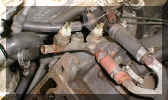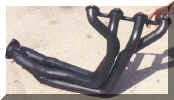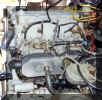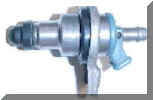A very common problem on 924's is the "hot-start problem." This is where the
car will start very nicely when cold, runs properly, and is properly tuned, but will not
start without a great deal of cranking when warm, if it has been let sit for more than 15
minutes or so after shutdown. This problem is usually caused by, for one reason or
another, not maintaining the high fuel pressure in the engine compartment. Most commonly
this is caused by injectors leaking after engine shutdown (they should close shut below a
certain minimum pressure) or fuel draining back into the tank - the fuel accumulators and
a check valve in the fuel pump (in some cases) should prevent this occurrence. If you are
experiencing hot-start problems (as opposed to general starting problems, hot or cold),
and the car is properly tuned and in good running order (no vacuum leaks, etc.), then
check the injectors and fuel accumulators.
From: Michael J. Brown
Email: 924martiirossi@email.msn.com
Date: 20 Apr 2000
Time: 21:02:26
Comments
I too was guilty of seeking a "quick fix" to my 924's cold start/warm
start/no start/running, problems. I then bought two excellent books on the Bosch Fuel
Injection Systems and became a student. I done a step-by-step test of the fuel system
and replaced any defective parts. My car now starts and stays running under all
conditions.
The advantage of this approach is: 1. You will learn the inner working of your car.
2. Avoid the costly repair bills 3. Realize that Bosch has a very well engineered
system.
The MJB
Michael J. Brown 924 Martini Rossi 80 931 81 924 (All great cars!)
Fuel pumps can get hot before they die. Porsche recommends using Chevron fuel
injector cleaner with Techron as a preventative maintenance on the fuel system; this
will help keep the fuel injection components from clogging up, and keep them lubricated.
This covers from the fuel pump to the injectors and everything in between. The biggest
enemy of the CIS system is dirt, which can jam in the tight clearances, followed by
water, which can cause rust that will jam the clearances. This should be done at least
every 15kmi.
For this reason, it is a very good idea, when restoring a car that has sat for a
while, to drain the fuel tank, flush with new clean fuel, and fill with fresh fuel
(after the flush runs clean) and Techron, before even attempting to start the car. Of
course, if you're reading this, chances are you've already sat behind the wheel for a
few hours trying to get the car to start without luck! Likewise, a fresh fuel filter is
a very good idea. However, make sure the fuel is clean first - nothing sucks more than
replacing a new fuel filter that has become clogged with old junk! Porsche's service
interval on the fuel filter is 30kmi.
Finally, down to the tests you can run, to check if your fuel pump is OK, dead, or
about to die.
The first test is to check that fuel is being delivered to the engine compartment at
an appropriate rate. According to the factory service manual, fuel delivery rate should
be at least 750cc in 30 seconds of fuel pump on time (turn on ignition and power the
fuel pump), as delivered in the engine compartment. To accomplish this test, clamp the
return line at the tank, disconnect it at the fuel distributor, and let it flow out of
the return line into a measuring container. If it flows less than 750cc, the pump may
need to be replaced.
The next step is to check the current consumption when running. With an ammeter
(which will measure the current drawn by the pump), the pump should use no more than
8.5Amps. If it's higher than that, your pump is likely on its way out.
Another consideration is to make sure that the screen on the fuel pickup (inside the
tank) is clean and clear. This can only be accessed by draining the tank and going
inside, unless the car has an in-tank fuel pump (though the tank will still have to be
drained, of course). It should be gently cleaned with fresh fuel and a soft toothbrush -
make sure to not push any debris into the pickup where it can be sucked into the main
fuel pump and damage that expensive pump. There is also an external filter or noise
baffle between the tank and pump, part #477 209 233 (VDO part #09 292 585), which may
get clogged and need to be cleaned or replaced.
Finally, how to determine if your car has one or two pumps. All cars have a
high-pressure pump external to the tank, clamped to the body behind the right rear
wheel. As of sometime in '79, an in-tank supply pump was added. However, not all '79
cars have one. The surest way to figure out if you have 2 pumps is to slide under the
car and look. If the car has an in-tank pump, the outlet from the fuel tank which goes
to the external pump will have 2 electrical connections and a huge hex on it, and is
actually the fuel pump. Single pump cars only have a nipple brazed into the tank wall,
no electrical connections.
One more final note, this about buying replacement pumps. Pierburg, a subsidiary of
Hella, makes replacement fuel pumps. The most commonly used external fuel pump on the
924 is 911.608.102.00, also used on the 77-80 911. The Pierburg replacement pump costs
less new than the rebuilt Bosch pumps. It works extremely well. It also has some
technical improvements over the OEM Bosch unit - it's quieter running, and uses plastic
roller pump elements instead of metal, so they a) won't rust, and b) are far more
tolerant of dirt than metal (since the plastic can "give" instead of jam tight
like metal). For this reason, look into getting the Pierburg pump instead of the Bosch
replacement. If your local parts vendor does not carry Pierburg pumps, contact All
European (http://www.alleuro.com) to order one. The
Pierburg part number (updated) is 98154.
There's one more advantage to this particular fuel pump. The early '77 cars used a
smaller pump. This pump, part number 810.906.091.B is very hard to come by, and can cost
up to about USD$400.The Bosch replacement pumps are not interchangeable, forcing owners
of the early cars to buy the expensive pump. The Pierburg pump, however, has fittings
such that it can in fact be swapped in to replace the early pump. The only
slightly difficult part is that the electrical connections are different, and must be
changed. However, the Pierburg pump comes with the required electrical connectors and
rubber protective boots (to seal against weather), so this is a minor job. Just make
sure to keep the connections straight (positive to positive) and use heat-shrink tubing
if you splice wires, and the pump can be upgraded easily.








